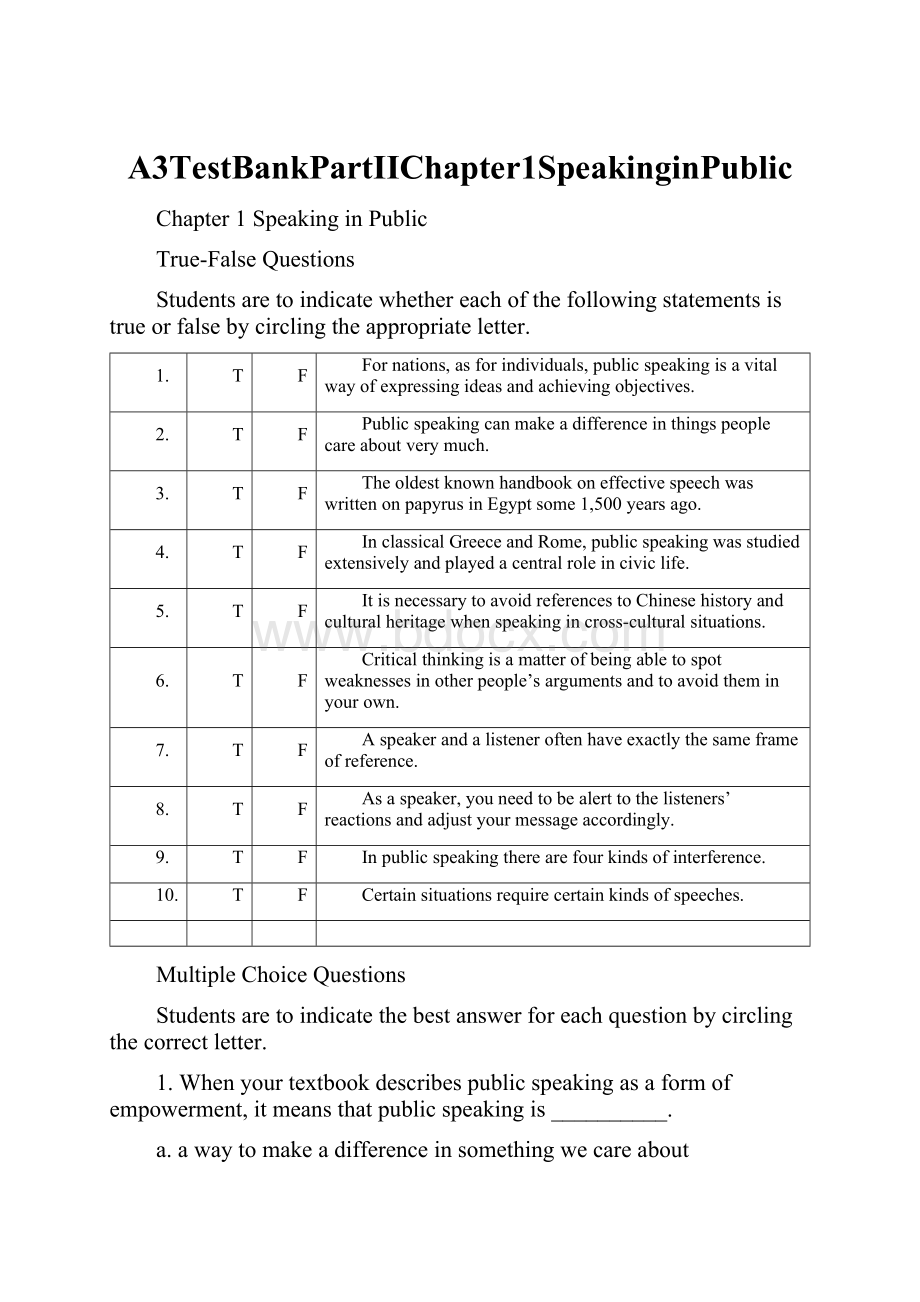 A3TestBankPartIIChapter1SpeakinginPublic.docx
A3TestBankPartIIChapter1SpeakinginPublic.docx
- 文档编号:25107223
- 上传时间:2023-06-05
- 格式:DOCX
- 页数:12
- 大小:18.99KB
A3TestBankPartIIChapter1SpeakinginPublic.docx
《A3TestBankPartIIChapter1SpeakinginPublic.docx》由会员分享,可在线阅读,更多相关《A3TestBankPartIIChapter1SpeakinginPublic.docx(12页珍藏版)》请在冰豆网上搜索。

A3TestBankPartIIChapter1SpeakinginPublic
Chapter1SpeakinginPublic
True-FalseQuestions
Studentsaretoindicatewhethereachofthefollowingstatementsistrueorfalsebycirclingtheappropriateletter.
1.
T
F
Fornations,asforindividuals,publicspeakingisavitalwayofexpressingideasandachievingobjectives.
2.
T
F
Publicspeakingcanmakeadifferenceinthingspeoplecareaboutverymuch.
3.
T
F
TheoldestknownhandbookoneffectivespeechwaswrittenonpapyrusinEgyptsome1,500yearsago.
4.
T
F
InclassicalGreeceandRome,publicspeakingwasstudiedextensivelyandplayedacentralroleinciviclife.
5.
T
F
ItisnecessarytoavoidreferencestoChinesehistoryandculturalheritagewhenspeakingincross-culturalsituations.
6.
T
F
Criticalthinkingisamatterofbeingabletospotweaknessesinotherpeople’sargumentsandtoavoidtheminyourown.
7.
T
F
Aspeakerandalisteneroftenhaveexactlythesameframeofreference.
8.
T
F
Asaspeaker,youneedtobealerttothelisteners’reactionsandadjustyourmessageaccordingly.
9.
T
F
Inpublicspeakingtherearefourkindsofinterference.
10.
T
F
Certainsituationsrequirecertainkindsofspeeches.
MultipleChoiceQuestions
Studentsaretoindicatethebestanswerforeachquestionbycirclingthecorrectletter.
1.Whenyourtextbookdescribespublicspeakingasaformofempowerment,itmeansthatpublicspeakingis__________.
a.awaytomakeadifferenceinsomethingwecareabout
b.awaytomakeeveryoneseethingsthroughourframeofreference
c.awaytodemonstratehowcleverweare
d.awaytomanipulatepeople
2.AlmostallcultureshaveanequivalentoftheEnglishword“__________”todesignatesomeonewithspecialskillsinpublicspeaking.
a.speaker
b.talker
c.lecturer
d.orator
3.Interculturalcommunicativecompetencebuildsupontraditionalcommunicativecompetencebutaddsthe__________requiredtomakeone’swayinaninterdependent,culturallydiverseworld.
a.awarenessandskills
b.knowledge
c.linguisticfluency
d.understanding
4.Becausepublicspeakingisanactof__________communication,itinvolvestheuseofEnglishasaworkinglanguage.
a.interpersonal
b.strategic
c.mass
d.business
5.CriticalthinkinginvolvesallofthefollowingrelatedskillsEXCEPT__________.
a.distinguishingfactfromopinion
b.judgingthecredibilityofstatements
c.controllingnervousnessandstagefright
d.assessingthesoundnessofevidence
6.Oneofthemajordifferencesbetweenpublicspeakingandordinaryconversationisthatpublicspeakingusuallyrequires__________.
a.adaptingtofeedbackfromlisteners
b.amoreformalmannerofdelivery
c.organizingideasforeffectivecommunication
d.tailoringthemessagetotheaudience
7.Ithasoftenbeensaidthattherearefewnewideasintheworld,only__________ideas.
a.reorganized
b.rediscovered
c.reemphasized
d.reinforced
8.Asyouworkonexpressingyourideasinclear,accuratelanguage,youwillenhanceyourabilitytothink__________.
a.clearlyandaccurately
b.effectivelyandclearly
c.logicallyandaccurately
d.cohesivelyandlogically
9.Inordertoorganizeyourmessage,youneedto__________.
a.tailoryourmessagetotheaudience
b.tellastoryformaximumimpact
c.organizeyourthoughtslogiclogically
d.adaptingtolistenerfeedback
10.AllofthefollowingtypesoflanguagehavelittleplaceinpublicspeechesEXCEPT__________.
a.slang
b.idiom
c.jargon
d.badgrammar
11.Listenersusuallyreactnegativelytospeakerswhodonot__________theirlanguagewhenaddressinganaudience.
a.elevateandpolish
b.watchanddecorate
c.controlanddecorate
d.elevateandwatch
12.Speechcommunicationbeginswitha__________.
a.listener
b.channel
c.speaker
d.message
13.WhichofthefollowingfactorsisNOTrelevanttoyoursuccessasaspeaker?
a.Yourmannerofspeaking.
b.Yourcircleoffriends.
c.Yourpersonalcredibility.
d.Yourknowledgeofthesubject.
14.The__________iswhateveraspeakercommunicatestosomeoneelse.
a.message
b.channel
c.feedback
d.situation
15.Inapublicspeakingclass,yourchannelisthemost__________ofall.
a.direct
b.active
c.worthy
d.personal
16.Thelistener’s__________referstothetotalofhisorherknowledge,experience,goals,values,andattitudes.
a.mentalityormindset
b.frameofreference
c.wayofthinking
d.fieldofexpertise
17.Tobeaneffectivepublicspeaker,youmustbe__________.
a.situation-centered
b.audience-centered
c.channel-centered
d.message-centered
18.WhichofthefollowingbehaviorisNOTanexampleoffeedback?
a.Listenerswearwarmclothes.
b.Listenersshuffletheirfeet.
c.Listenersleanforwardintheirseats.
d.Listenersgazeattheclock.
19.Interferenceisanythingthat__________thecommunicationofamessage.
a.influences
b.controls
c.impedes
d.involves
20.Funerals,weddings,graduationceremoniesareexamplesof__________.
a.channel
b.situation
c.interference
d.feedback
21.Asyoupresentyourspeech,younoticethatmanyofyourlistenershaveinterestedlooksontheirfacesandarenoddingtheirheadsinagreementwithyourideas.Accordingtoyourtextbook,thesereactionsbyyourlistenersarecalled__________.
a.interference
b.cognitivecues
c.feedback
d.audiencecues
22.Accordingtoyourtextbook,alisteneranxiousaboutanupcomingexam,worriedaboutarecentargumentwithafriend,ordistractedbycoldairintheclassroomwouldbeexperiencing__________.
a.situationalcues
b.interference
c.communicationapprehension
d.psychologicaldissonance
23.Concernbyalisteneraboutanupcomingjobinterview,thelackofairconditioning,oratoothacheareallexamplesof__________inthespeechcommunicationprocess.
a.feedback
b.interference
c.avoidance
d.blockage
24.Recognizingthattheaudienceforhisgraduationspeechwouldbepackedintoanon-air-conditionedgymnasiumduringthehottestweekoftheyear,LinYangdecidedtokeephisspeechatthelowendofhis10-to-15-minutetimelimit.Inmakingthisdecision,whichelementofthespeechcommunicationprocesswasLinYangadaptingto?
a.Location.
b.Feedback.
c.Situation.
d.Message.
25.AringingcellphoneoranaudiencememberbrowsingtheWebonherlaptopduringaspeechareexamplesof__________inthespeechcommunicationprocess.
a.channel
b.message
c.interference
d.feedback
26.Whateveraspeakercommunicatestosomeoneelseistermedthe__________.
a.channel
b.message
c.code
d.feedback
27.What,accordingtoyourtextbook,isthetermforanythingthatimpedesthecommunicationofamessage?
a.Interference.
b.Blockage.
c.Intrusion.
d.Avoidance.
28.Someonecoughingintheaudienceorwalkinginlateduringapresentationareexamplesof__________inthespeechcommunicationprocess.
a.channel
b.message
c.feedback
d.interference
29.Themeansbywhichamessageiscommunicatedistermedthe__________.
a.occasion
b.channel
c.catalyst
d.setting
30.Asdefinedinyourtextbook,channelinthespeechcommunicationprocessrefersto__________.
a.thefeedbacksenttoaspeakerbythelistener
b.themeansbywhichamessageiscommunicated
c.thecontentaspeakercommunicatestosomeoneelse
d.theprocessbywhichlistenersadapttothespeaker
31.__________letsyouknowhowyourmessageisbeingreceived.
a.Vocalvariety
b.Credibility
c.Feedback
d.Interference
32.AsLiuXiaoliapproachedthepodium,loudvoicesfromthehallwayfilledtheroom.Beforebeginningherspeech,sheaskedsomeoneinthebackoftheroomtoclosethedoor.Inthiscase,Benitawasdealingwith__________.
a.stagefright
b.interference
a.audienceattitudes
b.feedback
33.Inthemidstofaspeechaboutvolcanoes,aspeakernoticesquizzicalexpressionsonthefacesofherlisteners.Inresponse,shesays,“Letmeexplainthatpointagaintomakesureit’sclear.”Whenthishappens,thespeakeris__________.
a.buildinghercredibility
b.compensatingforthesituation
c.adaptingtofeedback
d.adjustingthechannel
34.AsZhangQiangdeliveredhisspeech,henoticedthatsomemembersofhisaudiencelookedconfusedasheexplainedoneofhismainpoints.Asaresult,hesloweddownandexplainedthepointagain.Inthiscase,ZhangQiangwas__________.
a.dealingwithexternalinterference
b.adaptingtoaudiencefeedback
c.adjustingthechannelofcommunication
d.interpretingtheaudience’sframeofreference
35.Dealingwithsuchmattersasthelogicalrelationshipsamongideas,thesoundnessofevidence,andthedifferencesbetweenfactandopinionareallpartofwhatyourtextbookcalls__________.
a.deduction
b.criticalthinking
c.rationalcommunication
d.oraldeliberation
36.Asyoulistentoaspeechaboutcampuscrime,yourelatethespeaker’sideastoyourownknowledge,goals,andexperience.Accordingtoyourtextbook,youarefilteringthespeechthroughyourown__________.
a.psychologicalscreen
b.cognitivefield
c.frameofreference
d.socialperspective
37.Whichofthefollowingaspectsofpublicspeakingisleastlikelytohelpstrengthenyourskillsasacriticalthinker?
a.Researchingyourspeech.
b.Outliningandorganizingyourspeech.
c.Testingthelogicofyourarguments.
d.Practicingthedeliveryofyourspeech.
38.Becauseeverypersonhasaunique__________basedonhisorherownknowledge,experience,andvalues,themeaningofamessagecanneverbeexactlythesametoalistenerastoaspeaker.
a.feedbackmechanism
b.attitudinalcore
c.frameofreference
d.psychologicalfield
39.
- 配套讲稿:
如PPT文件的首页显示word图标,表示该PPT已包含配套word讲稿。双击word图标可打开word文档。
- 特殊限制:
部分文档作品中含有的国旗、国徽等图片,仅作为作品整体效果示例展示,禁止商用。设计者仅对作品中独创性部分享有著作权。
- 关 键 词:
- A3TestBankPartIIChapter1SpeakinginPublic
 冰豆网所有资源均是用户自行上传分享,仅供网友学习交流,未经上传用户书面授权,请勿作他用。
冰豆网所有资源均是用户自行上传分享,仅供网友学习交流,未经上传用户书面授权,请勿作他用。


 《初级会计实务》试题题库大全及答案详解.docx
《初级会计实务》试题题库大全及答案详解.docx
